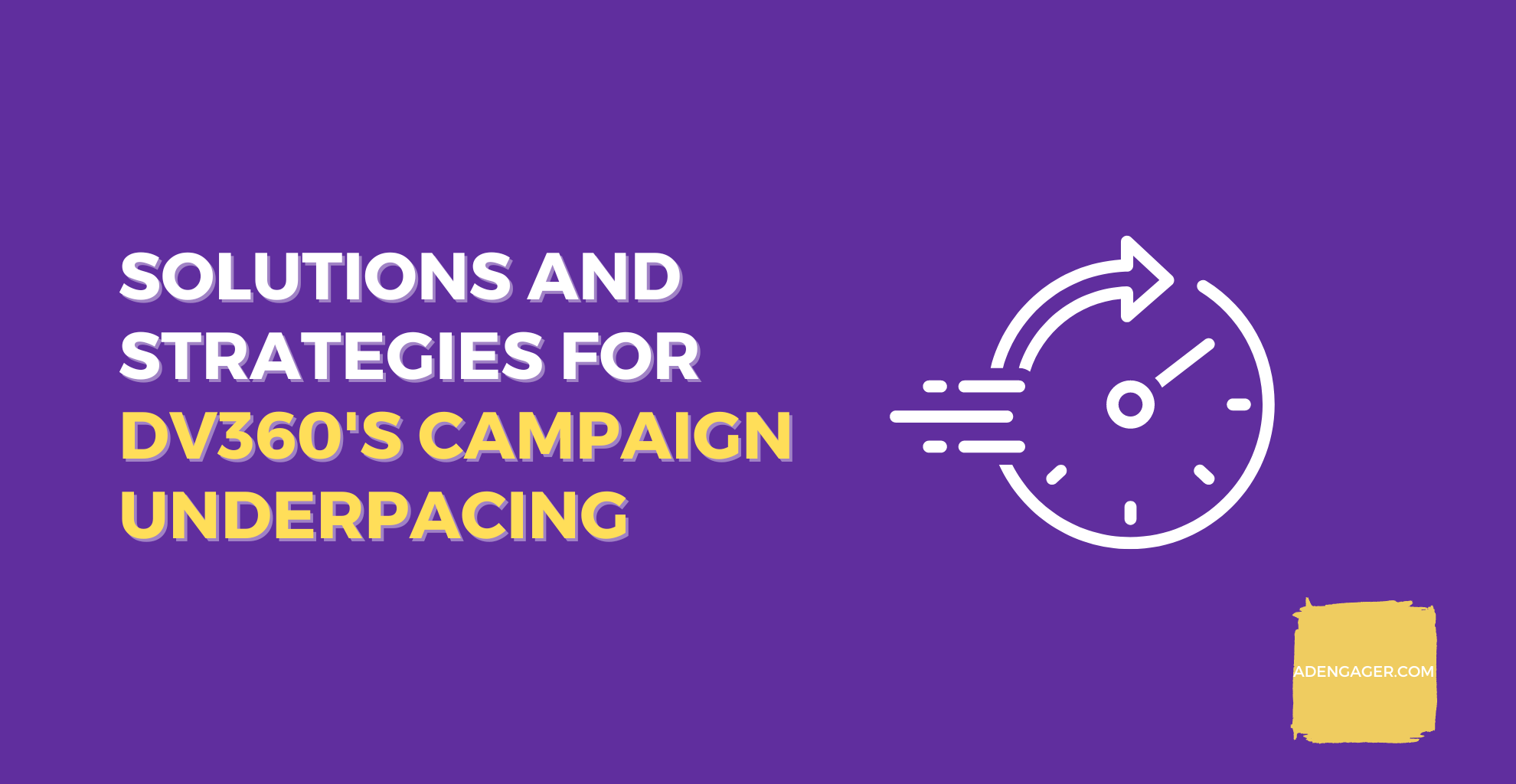DV360’s Campaign Underpacing |Solutions and Strategies

DV360 is a sophisticated programmatic advertising platform developed by Google, offering advertisers a comprehensive suite of tools to manage their display and video campaigns. Its power lies in reaching the right audience at the right time, but even the most advanced tools are only as effective as their management. One crucial aspect of campaign management, often overlooked, is campaign pacing. In this blog, we delve into the significance of campaign pacing within DV360 and explore the reasons behind underpacing – a common challenge that can hinder the success of your digital advertising efforts. We’ll also provide valuable insights and strategies to help you avoid underpacing and achieve your campaign goals more effectively. So, whether you’re a seasoned digital marketer or just starting your journey in programmatic advertising, this blog is your guide to mastering campaign pacing in DV360.
What is Underpacing in DV360 Campaigns?
A. What is Underpacing: Underpacing in DV360 refers to a situation where a digital advertising campaign fails to spend its allocated budget or deliver impressions at the desired rate over a specific period. Your campaign is not pacing as expected, falling behind in budget utilization and impression delivery.
B. Why underpacing is a concern: Underpacing is a significant concern in digital advertising for several reasons. Firstly, it can lead to inefficient resource allocation. Advertisers set budgets and goals based on specific performance expectations, and when a campaign underpaces, it fails to make the most of the allocated budget. Secondly, underpacing can result in missed opportunities. If your campaign is not delivering impressions as planned, it may not reach your target audience effectively, potentially costing you valuable conversions and brand exposure. Lastly, underpacing can be a sign of underlying issues in your campaign’s setup, targeting, or bidding strategy, which, if addressed, can lead to long-term performance problems.
C. Its impact on campaign performance: The impact of underpacing on campaign performance can be substantial. It can result in decreased reach and limited exposure to your audience, ultimately affecting brand visibility and engagement. Additionally, underpacing can lead to missed conversion opportunities, as your ads may not be shown to potential customers when they are most likely to convert. Overall, underpacing can undermine the effectiveness of your digital advertising efforts and hinder your ability to achieve your campaign objectives. Therefore, understanding the causes of underpacing and how to address them is crucial for optimizing your DV360 campaigns.
Reasons for DV360 Campaign Underpacing
A. Budget-related Factors
- Insufficient budget allocation: Underpacing can occur when your campaign’s budget is too conservative for the goals you aim to achieve. If the budget is too low relative to the campaign’s targeting and reach potential, it may not be able to spend effectively.
- Daily budget caps: Setting daily budget caps that are too restrictive can also lead to underpacing. When these caps are reached early in the day, your campaign may pause, resulting in missed opportunities to display your ads during peak engagement times.
- Competitive bidding: In a highly competitive advertising environment, aggressive bidding by competitors can drive up ad costs and limit your campaign’s ability to secure impressions within your budget constraints, contributing to underpacing.
B. Ad Creative Issues
- Low-quality creatives: Advertisements with subpar creative content may need help to attract user engagement and clicks. It can lead to underpacing as the algorithm prioritizes higher-performing ads.
- Limited ad variations: Running campaigns with a limited number of ad variations can lead to ad fatigue among your target audience. Users who see the same ad repeatedly are less likely to engage with it, impacting campaign performance.
C. Targeting and Audience Problems
- Narrow audience selection: More relaxed audience targeting can result in limited opportunities for your campaign to reach potential customers. When your audience is narrower, it can lead to underpacing as the platform struggles to find eligible impressions.
- Audience saturation: On the flip side, if you repeatedly show ads to the same audience without refreshing or expanding your targeting parameters, audience saturation can occur. It can lead to ad fatigue and underpacing as your ads become less effective.
D. Bid Strategy and Optimization
- Inappropriate bidding strategies: Choosing the right strategy for your campaign objectives can help its performance. If your bidding strategy doesn’t align with your goals, you may not win auctions at the desired rate, resulting in underpacing.
- Lack of ongoing optimization: Failing to monitor and optimize your campaign regularly can lead to underpacing. Campaigns require adjustments based on real-time performance data, and paying attention to this aspect can prevent your ads from reaching their full potential
E. Technical Glitches
- Platform or tracking issues: Technical glitches within the DV360 platform or tracking systems can disrupt campaign delivery. These issues can range from tracking pixel malfunctions to data discrepancies, affecting your campaign’s ability to pace properly.
- Ad approval delays: Ad creative approvals can also contribute to underpacing, as ads may start running differently than scheduled. It could be more problematic for time-sensitive campaigns.
F. Programmatic Deals
- Programmatic deal restrictions: In cases where programmatic deals have stringent restrictions or limitations, it can hinder the platform’s ability to deliver impressions efficiently, leading to underpacing.
- Ineffective deal setups: Poorly configured programmatic deals, such as inaccurate targeting or bid settings, can result in underpacing as the system struggles to find suitable impressions within the constraints of the deals.
Impact of Campaign Underpacing on Campaign Goals
A. Decreased reach and impressions: Underpacing directly affects the reach and impressions of your advertising campaign. When your campaign fails to deliver impressions at the expected rate, your ads are displayed less frequently to your target audience. It reduces exposure, making it challenging to build brand awareness and engage potential customers effectively. Ultimately, a decrease in reach and impressions can limit the overall impact of your campaign on your target audience.
B. Missed conversion opportunities: In digital advertising, timing is crucial. Underpacing can lead to missed conversion opportunities because your ads may not be shown to potential customers when they are most likely to take action, such as making a purchase or filling out a form. When your campaign fails to reach its pacing goals, it hampers your ability to capture leads, generate sales, or achieve other conversion-related objectives. It can result in lower return on investment (ROI) and a less successful campaign overall.
C. Inefficient resource utilization: Underpacing often means your campaign needs to utilize its allocated resources more efficiently. Advertisers set budgets based on expected performance and goals. When a campaign is underpacing, it may only spend part of its budget, leaving resources unused. This inefficiency can be costly, as your budget is not maximized to achieve your marketing objectives. It’s like paying for a service but needing to fully utilize what you’ve paid for, which can lead to suboptimal outcomes and potentially increased costs per conversion or engagement.
Understanding the impact of underpacing is crucial for digital advertisers, as it highlights the importance of proactive campaign management and the need to address the underlying issues causing underpacing. By mitigating underpacing and optimizing campaign performance, you can maximize your reach, capture valuable conversion opportunities, and use your advertising resources more efficiently.
Strategies to Avoid Underpacing
A. Budget Planning and Allocation
- Setting realistic budgets: Conduct thorough research and analysis to determine an appropriate budget for your campaign. Understand your campaign goals and the competitive landscape to set a budget that aligns with your objectives. Avoid underbudgeting, which can lead to underpacing.
- Adjusting daily spend caps: Monitor your campaign’s daily spending and adjust caps as needed. If you notice that your campaign is consistently hitting daily spend limits early, consider increasing the caps to ensure a steadier flow of impressions throughout the day.
B. Ad Creative Optimization
- A/B testing: Continuously test different ad creatives to identify which resonates most with your target audience. A/B testing helps improve ad performance and engagement rates, reducing the risk of creative fatigue and underpacing.
- Dynamic creatives: Implement dynamic creative optimization (DCO) to automatically tailor ad content to individual users based on their preferences and behavior. Dynamic creatives can enhance relevancy and boost click-through rates, mitigating underpacing.
C. Targeting and Audience Management
- Broaden audience reach: Consider expanding your target audience parameters to reach a wider audience pool. A more inclusive approach can prevent underpacing by increasing the available impressions and reach.
- Regularly refresh audience lists: Keep your lists up-to-date by regularly refreshing them with new data. Stale audience lists can lead to audience fatigue and underpacing.
- Use of negative keywords: Utilize negative keywords to refine your audience targeting further. Negative keywords help exclude irrelevant traffic and ensure your ads are shown to the most relevant audience, reducing the risk of underpacing.
D. Bid Strategy and Optimization
- Optimize bidding strategies: Review and refine your bidding strategies to align with your campaign goals. Choose bidding strategies that maximize your chances of winning auctions at a pace consistent with your objectives.
- Monitor and adjust in real-time: Constantly monitor campaign performance and make adjustments as necessary. If you notice underpacing, be prepared to adjust your bidding strategy, budgets, or targeting parameters promptly.
E. Technical Troubleshooting
- Regularly check for tracking issues: Inspect your campaign’s tracking setup to identify and resolve any technical issues hindering proper pacing. Ensuring accurate tracking is crucial for campaign success.
- Communicate with DV360 support: If you encounter persistent technical issues, don’t hesitate to contact DV360’s customer support for assistance. Timely communication can help resolve problems and prevent underpacing.
F. Programmatic Deals Management
- Review and optimize programmatic deals: Regularly evaluate the performance of programmatic deals and make adjustments as needed. Optimize deal settings to align with your campaign goals and budget constraints.
- Ensure deal setups align with campaign goals: When setting up programmatic deals, ensure that deal parameters, such as targeting and bid settings, are compatible with your campaign objectives. Misaligned deals can contribute to underpacing.
In conclusion, mastering campaign pacing in DV360 is essential and highly achievable with the right strategies and a proactive approach. We’ve explored the various facets of underpacing, from its Definition to the common reasons behind it and its far-reaching consequences on campaign performance. What stands out is the pivotal role of proactive campaign management. Advertisers must set realistic budgets, optimize ad creatives, fine-tune targeting parameters, and continually adjust bidding strategies. Moreover, the dynamic nature of digital advertising calls for constant monitoring and optimization, ensuring campaigns remain aligned with evolving goals and audience behaviors. DV360 offers a robust toolkit, but success hinges on its effectiveness. By implementing the discussed strategies and maintaining vigilance, advertisers can not only sidestep underpacing but also harness the full potential of DV360, ultimately achieving their campaign objectives in the ever-evolving digital advertising landscape. Stay proactive, stay agile, and optimize to maximize your advertising success.






